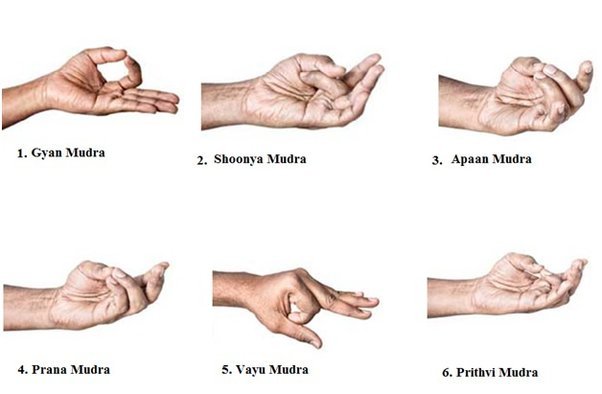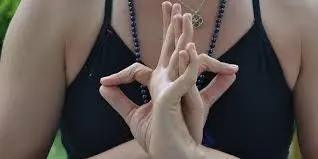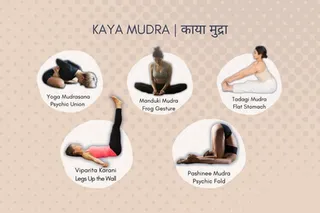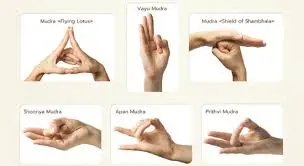Yoga mudra often called ‘seals’ or ‘gestures,’ are fundamental components of yoga practice that involve specific hand positions, body postures, and sometimes subtle movements. These ancient techniques are designed to stimulate energy flow within the body and mind, facilitating physical, mental, and spiritual well-being. Each mudra carries its unique significance and benefits, influencing different aspects of our being. Some mudra focuses on calming the mind and reducing stress, while others aim to enhance concentration, boost vitality, or even promote healing.
Despite their simplicity, yoga mudra possesses profound potential to influence our inner state and outer experiences. By incorporating these gestures into our yoga practice, we can tap into their transformative power and cultivate greater harmony, balance, and alignment in our lives.
Contents
Origins of Yoga Mudra
The origins of yoga mudras trace back to ancient Indian traditions, particularly within the realms of yoga, meditation, and spirituality. Yoga Mudras have been an integral part of these practices for thousands of years, with roots in Hinduism, Buddhism, and Jainism.
In Hinduism mudra is mentioned in ancient texts such as the Vedas and Upanishads, which date back thousands of years. These texts describe various hand gestures and body postures used during rituals, meditation, and worship ceremonies to evoke specific energies, deities, or states of consciousness.
The classical text of yoga, the Yoga Sutras of Patanjali, also references yoga mudra as one of the components of yoga practice. Patanjali describes mudras as a means to control the flow of prana (life force energy) and achieve higher states of consciousness.
Also Read 🙁 What is Bhakti Yoga )
What is Mudra in Yoga
In Sanskrit, the word ‘mudra’ translates to ‘seal’ or ‘mark,’ symbolizing the idea of sealing or locking in a particular energy or intention. When performed with mindfulness and intention, yoga mudra can deepen the practitioner’s connection to themselves and their surroundings.
Mudras are an integral part of yoga practice and are believed to influence the flow of energy in the body and promote physical health, mental well-being, and spiritual awakening. They are often used in conjunction with breathing techniques ( 7 types of pranayama), meditation, and asanas (physical postures) to deepen the practitioner’s experience and facilitate specific energetic or psychological effects.
Different Types of Mudra
Hasta Mudras (Hand Mudra):

This mudra involves gestures performed with the hands and fingers. Examples include:
-
- Anjali Mudra (Prayer Gesture): Bringing the palms together at the heart center.
- Chin Mudra (Consciousness Gesture): Touching the tip of the index finger to the tip of the thumb, with the other three fingers extended.
- Gyan Mudra (Knowledge Gesture): Touching the tip of the index finger to the tip of the thumb, while keeping the other three fingers extended.
- Shuni Mudra (Seal of Patience): Touching the tip of the middle finger to the tip of the thumb while extending the other fingers.
Bandha Mudras (Locks or Seals):

This yoga mudra involves contracting specific muscles or body parts to direct the flow of energy. Examples include:
-
- Mula Bandha (Root Lock): Engaging the pelvic floor muscles.
- Uddiyana Bandha (Abdominal Lock): Drawing the abdomen inward and upward.
- Jalandhara Bandha (Throat Lock): Tucking the chin towards the chest and lowering the head slightly.
Adhara Mudras (Perineal Mudras):

Mudras that focus on the activation of energy centers located in the perineum. Examples include:
-
- Ashwini Mudra (Horse Gesture): Involuntary contraction and relaxation of the anal sphincter muscles.
- Vajroli/Sahajoli Mudra: Control and manipulation of the muscles in the pelvic region.
Kaya Mudras (Postural Mudras):

These mudras involve specific body postures or movements. Examples include:
-
- Yoga Mudra: Sitting with crossed legs and interlocking the fingers behind the back, then bending forward.
- Manduki Mudra (Frog Gesture): Squatting with the heels touching and the knees spread apart, resembling a frog.
Mantra Mudras:

Mudras are performed in conjunction with the chanting of mantras. The Yoga mudra enhances the vibrational effects of the mantra. An example is the Gyana Mudra performed while chanting “Om.”
Understand Mudra Benefits
- Balancing Energy Flow: Mudras are believed to influence the flow of prana (life force energy) throughout the body. By practicing mudras, individuals can balance the energy flow in specific energy channels (nadis) and chakra, promoting overall vitality and health.
- Stress Reduction: Many mudras are designed to calm the mind, reduce stress, and promote relaxation. By engaging in these hand gestures or body postures, individuals can activate the parasympathetic nervous system, leading to a sense of calmness and inner peace.
- Enhanced Concentration and Focus: Certain mudras, such as Chin Mudra and Gyan Mudra, are known for their ability to improve concentration and mental clarity. Practicing these mudras can help sharpen the mind, increase focus, and enhance cognitive function.
- Emotional Stability: Mudras have a profound effect on the emotional state, helping to regulate mood and promote emotional balance. By stimulating specific energy points in the body, mudras can alleviate feelings of anxiety, depression, and agitation, fostering emotional well-being.
- Physical Health: Different mudras are associated with various physical health benefits, including pain relief, improved digestion, strengthened immune function, and hormonal balance. For example, certain mudras like Vayu Mudra are believed to alleviate gas-related issues and promote digestive health.
Techniques of Practicing Yoga Mudras
- Hand Positioning: Most yoga mudras involve intricate hand gestures, where fingers are placed in precise configurations. The positioning of the fingers is crucial, as each finger represents different elements and qualities. Practitioners typically hold the mudra with both hands, although some mudras may involve using only one hand.
- Body Posture: While practicing mudras, maintaining a comfortable and steady body posture is essential. Depending on the mudra, practitioners may sit in a cross-legged position (such as Sukhasana or Padmasana), kneel, or even stand. The spine should be erect, allowing for smooth energy flow throughout the body.
- Breath Awareness: Conscious breathing is often integrated into yoga mudra practice to deepen the experience and enhance its effects. Practitioners may synchronize the mudra with specific breathing techniques, such as deep diaphragmatic breathing or alternate nostril breathing (Nadi Shodhana). Breath awareness helps calm the mind, regulate energy flow, and deepen the meditative aspect of the practice.
- Mental Focus and Intention: Mindfulness and intention play a significant role in yoga mudra practice. Practitioners focus their attention on the mudra, visualizing the flow of energy within their body. They may also cultivate a specific intention or mantra associated with the mudra, directing their thoughts towards healing, transformation, or spiritual awakening.
- Duration and Repetition: Mudras can be practiced for varying durations, depending on individual preferences and goals. Some practitioners hold mudras for a few breaths, while others may maintain them for several minutes or even longer during meditation sessions. Repetition of the mudra over time can deepen its effects and enhance its benefits.
